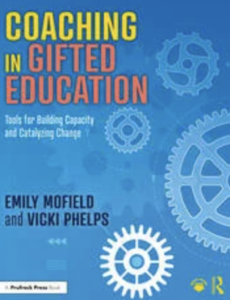Coaching That Builds GT Teacher Capacity
Coaching in Gifted Education: Tools for Building Capacity and Catalyzing Change
By Emily Mofield and Vicki Phelps
(Routledge/Prufrock Press, 2024 – Learn more)
Reviewed by Kim Rensch

The authors, prominent voices in the world of gifted education, propose a “GT Coaching Circuit” with components that would apply easily in any coaching scenario, making this book a valuable read for instructional coaches in any classroom setting.
The Reading Experience

Because coaching is a nuanced art, it is never a bad idea to revisit the practices for the purpose of refining our craft. Mofield and Phelps carefully braid together a collection of frameworks, models, dispositions, behaviors, and actions from the world of instructional coaching to form this comprehensive guide to GT coaching.
The authors speak to the coaching craft in chapter one, “Coaching as a Catalyst for Change.” Gifted education specialists, they argue, can raise the rigor for highly-abled learners through coaching partnerships with general education teachers.
Because children in need of gifted services only spend a small percentage of their school day with a gifted education specialist, it is necessary to have teachers who can adeptly differentiate lessons to provide appropriately challenging learning opportunities for all students. Mofield and Phelps refer to this work as “differentiating up.”
From Purpose to Planning to Reflecting
Chapter two offers an overview of the GT Coaching Circuit, a three-phase model of coaching that takes teachers from setting their purpose to planning for learning to reflecting on outcomes. These phases are explained in depth in chapters four, five, and six. What I really appreciated about chapter two was its inventory of what makes for a successful GT coach. The writers assert that GT coaches are “change agents and co-thinking partners” (29), specialists who “think with the teacher and serve beside them (not above them)” (29). Seasoned coaches will likely appreciate this chapter’s reminders of the temperaments and traits of a good instructional coach.
The book ends with chapter seven’s call to partner with other stakeholders. This chapter includes administrator look-fors and a sample plan from a school district that began incorporating GT coaching as part of its gifted education program. The authors also use this chapter to offer suggestions for making in-roads with colleagues, as instructional coaching can be a difficult sell for some teachers. Readers will likely find this chapter to be a thorough finale to a comprehensive guide to GT coaching.
A Note About the Appendices
Like the appendices in other books written by these authors, Coaching in Gifted Education‘s appendices offer a wealth of practical resources for a GT coach to turn to again and again. Appendix A is a menu of coaching questions to ask during the three phases of the GT Coaching Circuit. Appendix D’s list of differentiation features would be a great model for creating menu options for highly-abled learners. For someone new to coaching, these tools are invaluable.
A Word of Advice for Reading This Book
Instructional coaching is complex enough in itself, without the added pressures of meeting the unique needs of students in gifted education. Due to this complexity, there are a lot of moving parts to attend to in the capacity of GT coach. It is virtually impossible, therefore, to write a book about coaching that is simple and straightforward.
Mofield and Phelps use several acronyms to describe the work of a coach. In chapter one, readers learn about the TEAM Framework for Collaborative Practice and the ADKAR Model. Hot on their heels is the SCARF Model described in chapter 2. It becomes a lot of acronyms to remember, and I found myself frustrated when they popped up in subsequent chapters because I could not always immediately recall the acronym.
The authors tried to remedy this by modeling an application of an acronym as it related to new information provided in the remainder of the book. Nevertheless, I found myself wishing that there was a glossary of these acronyms in the end matter, or that I had just simply written them down for myself for quick review when they popped back up. Readers might want to have some sticky notes handy for jotting these down or marking where they are in the book.
Despite the acronym-juggling, this book is a rich resource for educators looking for ways to meet the needs of exceptional learners. Mofield and Phelps are the partners GT coaches need to be the partners that classroom teachers need.
Kim Rensch (@KJRensch) is a National Board Certified Teacher working as a member of the Gifted Services team for Fargo Public Schools in North Dakota. She is a Teacher-Consultant in the Red River Valley Writing Project and a board member of the North Dakota Association for Gifted Children. When she’s not doing something literacy- or school-related, Kim can be found spending time with her husband, their dogs, or with her many plants and flowers.































